The Best Greek Islands to Visit for Wine Lovers
With a bounty of vines and great local produce, the Cyclades have more to offer than just sun and sea.
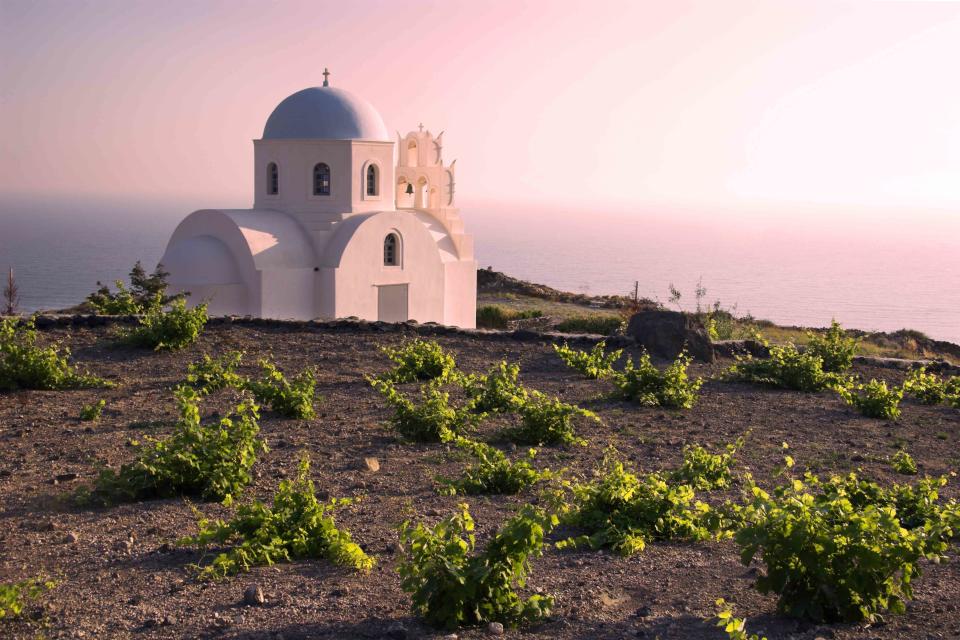
MICK ROCK/CEPHAS PICTURE LIBRARY
To protect grapes from the island's harsh maritime winds, vines in Santorini are handwoven and trained into low basket shapes called kouloura, which allow fruit to grow safely inside.The island of Santorini has had vines for nearly as long as it has had sunsets, and the best of the wines it produces are equally spectacular: stony whites that bathe the taste buds in a bright mineral glow. When evening falls, crowds gaze out across the caldera as the sea ahead of them and the white buildings behind turn a luminous orange, unaware that the volcanic eruption in about 1600 B.C. that left only this west-facing crescent jutting above the waves also layered the island with volcanic debris that today gives rise to unique and wonderful wines.
Santorini is the most famous vine-growing island in the Cyclades region, just southeast of the Greek mainland. Even Mykonos, which no longer makes much wine, had vineyards (and fig, olive, and apple trees) supplying the Temple of Apollo back in the third century B.C. Surely, I figured, a region that could keep the gods well fed would have a few treats for me, too. So I asked winemakers where to eat and restaurateurs what to drink, and I consulted travel experts for their tips. They all talked about the amazing vegetables and pungent herbs, the freshest fish, and exceptional cheeses. And once I got there, I also talked to hoteliers, which turned out to be risky: None of them could bear to hold a conversation without feeding me.
I found two styles of cooking on the islands, one rustic, the other sophisticated — but both plucked ingredients from the surrounding fields, and both drew on ideas from the past. Traces of the old ways were faintly visible even on smart, modern menus, like the sunken second curve of Santorini’s caldera beneath the surface of the Mediterranean.
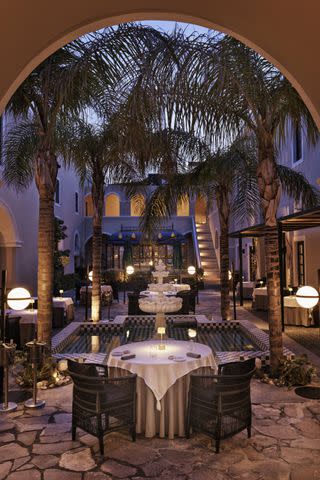
COURTESY OF KATIKIES GARDEN SANTORINI
Selene at the Katikies Garden hotel.On a sun-dappled terrace on Naxos, a group of us gathered to learn the ancient art of cooking over a wood fire. Appropriately for an island referred to by first-century B.C. Roman poet Virgil as “famed for vintage,” our day had begun with wine, when Maria Polikreti greeted us with tiny glasses of rosy red wine — very refreshing, even if it was 10:30 a.m. Her mother, Juliana, then showed us how to hollow out giant tomatoes, eggplants, and zucchini from the vast tiered kitchen garden and to pack them with rice and herbs for a dish called gemista (which means “stuffed”), Maria offering encouragement and Juliana making effective use of her three words of English: “Bravo, very good!”
Related: These 7 Greek Wines Are Highly Underrated
This dish went into the humpbacked oven, along with hunks of lamb thrown into an earthenware pot with rosemary, bay leaves, wild oregano, chunks of potato, cut oranges, and a half-jug (“the Greek version of a teaspoon”) of olive oil. The potatoes were sprinkled with dried mint so pungent it smelled like licorice. From a makeshift roof hung the biggest bunch of onions I have ever seen. Loukoumades, doughnuts drizzled with honey and sprinkled with cinnamon, concluded the huge meal.
I was offered a lift back to my hotel by Maria’s husband, Ioannis Margaritis, the governor of Naxos and owner of Naxian on the Beach hotel, a trip that included a detour for a glass of wine on the hotel terrace facing the water. That glass came accompanied by a parade of dishes including smoky chargrilled prawns over Naxian grains, and local tuna topped with colorful slivers of pepper and strawberry. My reminders that I’d just eaten half a lamb did no good. I was here to explore the culinary delights of the Cyclades, and Margaritis was making sure I did just that.
The day before, on Tinos’ windy heights, I had admired orderly rows of vines improbably located among tumbled granite boulders called volakes, which reappeared in the wines as minerality and finesse, over-laid with saltiness from those sea breezes. I was surprised at the wines’ elegance in this wild, almost waterless environment, where millennia of wine-making ended because of wars, pirates, and disease: “This is a very austere place,” said Eleni Blouchou of T-Oinos winery. T-Oinos is another blend of old and new, a 21st-century collaboration between Alexandros Avatangelos, Alain Ducasse’s head sommelier Gérard Margeon, and renowned wine consultant Stéphane Derenoncourt that has brought back the vines.
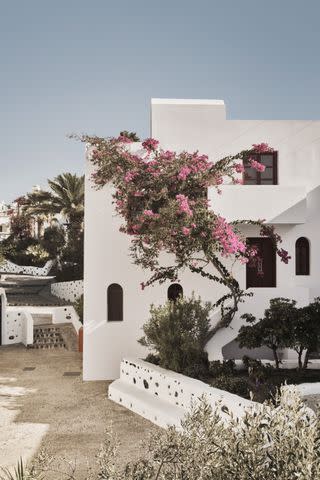
COURTESY OF VEDEMA RESORT
Classic Cyclades architecture at Vedema resort on Santorini, Greece..T-Oinos’ reds and rosés are made from Mavrotragano grapes, the whites from Assyrtiko. Both varieties come from Santorini, where vines grow in nests, close to the volcanic soil. The leaves shelter the grapes like a mother hen with her chicks. There are vines here said to be 200 years old, but at his new winery in his family’s old cellar on the island’s northern tip, Paris Sigalas goes back still further, vinifying his superb Assyrtikos in amphorae, the terracotta vessels the ancients used before barrels were invented. Now in his 70s, he has swapped the thriving Sigalas winery for this tiny project he has named Oeno P. He says winemaking is “like jazz: First there’s dissolution, then synthesis.” He was referring to his Tria Ampelia, from three single vineyards of old Assyrtiko vines, which was as clear and pure as a ringing bell.
Related: 7 Food and Drink Rules Greeks Live By, According to a Local
There were more great wines in Selene, a restaurant in the tranquil cloistered courtyard of the Katikies Garden hotel that has been overseen by chef Ettore Botrini, of Michelin-starred Botrini’s, and Master of Wine Yiannis Karakasis since 2021. The hotel was once part of the monastery next door. (“There are still nuns there. We have never seen them, but we see their tomato plants,” a server told me.) And those wines accompanied magnificent food, again inspired by traditional Cyclades gastronomy: bread made with a broth of fava beans and carrots rather than water; smoked eel with capers and pollen; tomatoes, grown with very little water, in forms from tartare to tart.
Everywhere I went, from vineyards and farms to restaurants, I found this same symbiosis: elegance in the wine and traces of rusticity in the restaurant. On Sifnos at Narlis Farm, George Narlis showed his guests how to grind fava flour using a giant millstone and make delicious dishes including beans with artichokes, mizithra (a creamy cheese), and lamb (although Sifnian cuisine, he said, is “mostly vegetarian”). At Cantina, a waterside restaurant on a rocky ledge below the town of Kastro, the food was a brilliant blend of local and international inspiration: We could opt for dry-aged fish collarbone or fish ribs cooked over charcoal — even allowing for rough translations from the Greek, both sounded intriguing. We ate calamari, grilled on an open fire with fresh beans and herbs, a gorgeous sequel to raw amberjack fish with seashore plants and crispy fried skin. Chickpea panisses, like giant french fries, were accessorized with a tangy sauce made from pumpkin. And at the elegant Kalesma hotel on Mykonos, the taramasalata, a traditional cod-roe dip, was pepped up with salty sea urchin, and thick pipes of sun-dried octopus were roasted with capers, wild sea greens, and Mykonian sausage “dust.” All these sophisticated dishes drew on traditions that were ancient even in Virgil’s time.
On our way to the Santorini airport, I squeezed in a last treat. At Gaia Wines, a few steps from the ocean, Leto Paraskevopoulou makes a wonderfully herbaceous Wild Ferment Assyrtiko and another called Ammonite, rich yet minerally and so good I’ve been searching for it ever since. The Cyclades may, these days, be famed for attractions other than vintage, but winemaking is deeply rooted in their soils. And some traditions are well worth traveling for.
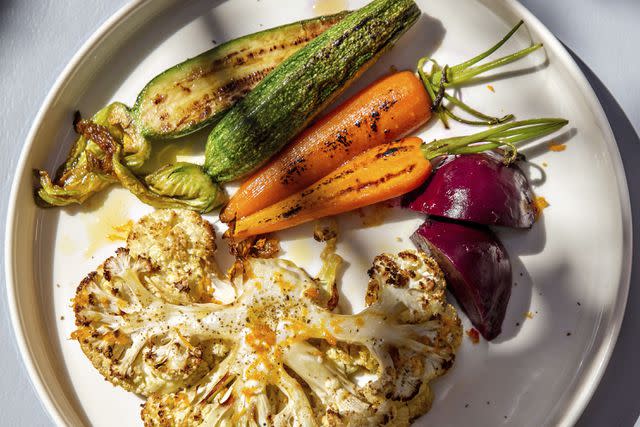
COURTESY MIKRO KARAVI
Simply grilled vegetables at Mikro Karavi on the island of Tinos, GreeceGetting there
There are no direct flights from the U.S. to the Cyclades; travelers can connect in transit through Athens for a short domestic flight or fly directly to Santorini or Mykonos via European hubs such as London, Milan, Frankfurt, or Paris. If you prefer the scenic route, various ferries shuttle between Athens and the islands, the fastest connecting Athens to Mykonos in 2.5 hours and Athens to Santorini in 4.5 hours.
Guided tours
Nina Caplan was the guest of Scott Dunn, whose experts can customize gastronomy-focused trips to the Cyclades with a 12-night stay throughout Mykonos, Naxos, Sifnos, and Santorini, including flights, ferries, and accommodation.
Where to eat, drink, and cook in the Greek islands
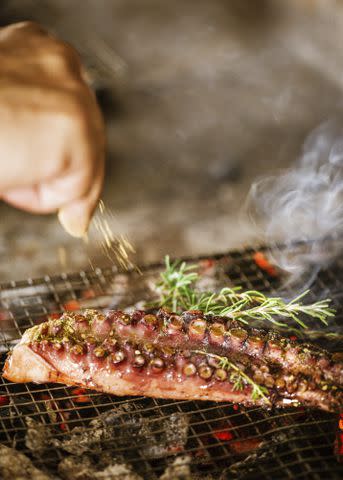
COURTESY OF KALESMA MYKONOS
A dish of chargrilled octopus, an island stapleTinos Town (Tinos)
At Tinos Town, a lovely restaurant in a peaceful courtyard near the ferry terminal, every check comes with a sweetener: a complimentary snifter of sweet red wine with spices.
Cantina (Kastro, Sifnos)
A zero-waste restaurant right on the water, Cantina is creatively reimagining traditional dishes and working hard to be sustainable as well as delicious.
Metaxi Mas (Exogonia, Santorini)
With a terrace overlooking the ocean, Metaxi Mas blends Cretan influence with local produce, plus the kind of wine list you’d expect from a place surrounded by wineries — especially when the winemakers all eat here.
Naxian Experiences (Naxos)
Anthony Bourdain was captivated by Juliana Polikreti’s cooking in a wood-burning oven and over an open fire between two rocks, and so was I. Naxian Experiences offers organic wood-fire cooking classes.
Rizes Folklore Farmstead (Mykonos)
This ancestral farm owned by the Zouganeli family and decorated with their heirlooms is near AnoMera. There are geese and horses (they offer horse riding with beach picnics), good food- and bread-making classes, and now simple accommodation, too.
Narlis Farms (Sifnos)
George Narlis farms without water and welcomes tourists into his homestead for cooking lessons, great food, and a good many stories.
Where to stay in the Cyclades
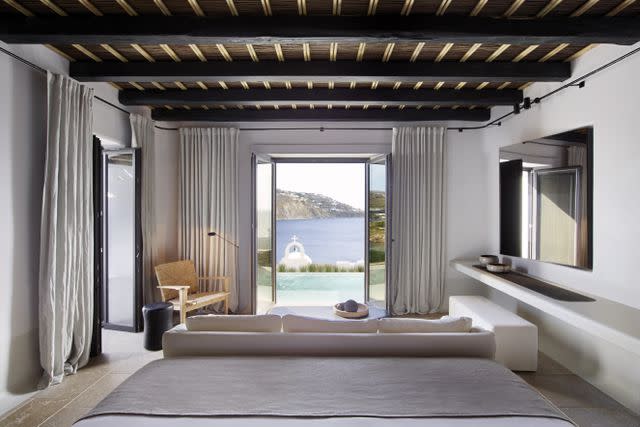
COURTESY OF KALESMA MYKONOS
Kalesma hotel on Mykonos offers Aegean Sea views.Kalesma (Mykonos)
Designed as a luxurious riff on a Mykonian village, Kalesma opened in 2021 with 28 suites and villas and a superb restaurant. Rooms from $1,103
Vedema Resort (Santorini)
In the wine village of Megalochori, the sprawling Vedema Resort (which evolved from a historic winery) has two pools, dramatic views of Santorini’s nestlike vines, and a 400-year-old wine cellar. Rooms from $393
Katikies Garden (Santorini)
A former monastery in Fira, Katikies Garden is now a luxury hotel with a rooftop pool and a superb restaurant, Selene, which focuses on local fare, in the former cloisters. Rooms from $413
Verina Astra (Sifnos)
Verina Astra is a lovely hotel with coastal walks into the town of Kastro and views out toward Paros from individual patios, the pool, or their restaurant, Bostani, which blends fine-dining techniques with local ingredients and has an excellent wine list. Rooms from $237
18 Grapes (Naxos)
Minutes from the beach on the west coast of Naxos, this small hotel is named for its 18 rows of grapevines. To top it off, 18 Grapes has a stunning poolside restaurant on the rooftop and a small, luxurious spa. Rooms from $253
For more Food & Wine news, make sure to sign up for our newsletter!
Read the original article on Food & Wine.

